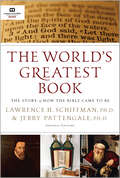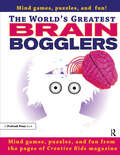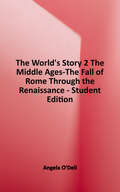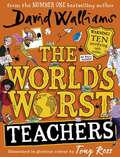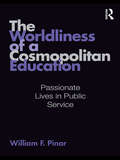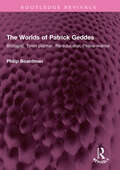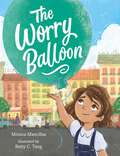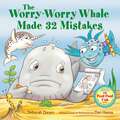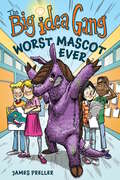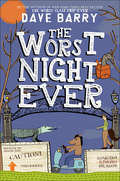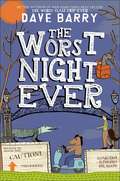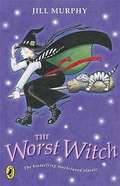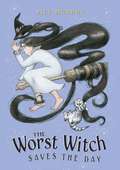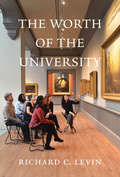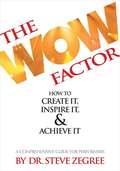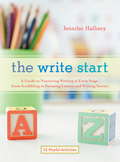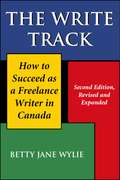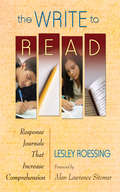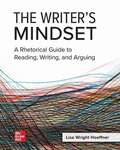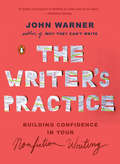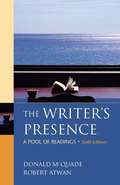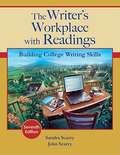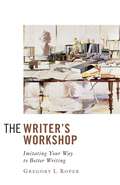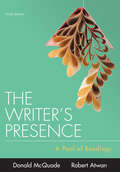- Table View
- List View
The World's Greatest Book: The Story of How the Bible Came to Be
by Lawrence H. Schiffman and Jerry PattengaleWelcome to the fascinating story of how we got the world's greatest book -- the Bible.It is a captivating story that includes a little bit of everything: adventure and violence, mystery and bravery, and dumb luck or divine intervention -- depending on your point of view.How in the world did we get this book that some people swear by and other people swear at? You don't have to be a skeptic to have a grocery list of questions about the formation of the Bible, such as: Who wrote these documents and when? How were these ancient writings transmitted through the ages? As scribes made copies of copies, didn't they make mistakes that caused the ancient writings to be changed and corrupted? How was it decided which writings would be included in the Bible? What are the Dead Sea Scrolls, and why are archaeological finds like these such a big deal?Devoted people dedicated their lives throughout time to put this unique book into the hands of people worldwide. Retrace the passion and intrigue behind the Bible's creation.
The World's Greatest Brain Bogglers: Grades 3-9
On January 1st, a girl said to a boy, "Two days ago, I was 7, but next year I'll be 10." She was telling the truth. Try to figure out how this could be possible.―Pamela Massey, 12What do you have when you are sitting down that disappears when you stand up?―Lindsay Lingerman, 12Your students will love these collections of games, puzzles, logic puzzles, word finds, riddles, and mazes―all by kids just like them! Each puzzle or game is by a kid, because these challenges are collected from the pages of Creative Kids, a magazine by and for kids―so you know that the brain bogglers in these collections will be perfect for your students. Sit back as your students use logic to create a mismatched monster, decrypt secret messages, and solve picture puzzles.Filled with hours of fun and challenge, there is something for everyone in these books, from corny riddles, to perplexing crosswords, to complicated puzzles―all written by kids, but challenging for any age.
The World's Story 2 The Middle Ages-The Fall of Rome Through the Renaissance - Student Edition
by Angela O'DellAngela O’Dell’s World’s Story series uses the same fun style of her popular America’s Story series to teach junior high students about world history. Students will learn about everything from the fall of Rome to the Renaissance in a survey that covers Europe, Asia, Africa, and the Americas. Written from a strong Christian perspective, students will see God’s hand throughout history and learn about how this history is still relevant to their lives today.
The World's Worst Teachers
by Tony Ross David WalliamsMillions of young readers have loved the World’s Worst Children tales – now they will revel in this delightfully dreadful collection of the most gruesome grown-ups ever: The World’s Worst Teachers. From the phenomenally bestselling David Walliams and illustrated in glorious colour by the artistic genius, Tony Ross. Think your teachers are bad? Wait till you meet this lot. These ten tales of the world’s most splendidly sinister teachers will have you running for the school gates. Dr Dread teaches science and is half man, half monster… Watch out for the ghastly Miss Seethe. She is ALWAYS furious – and she’s on a detention rampage. And as for Pent, he’s a teacher with a real difference. He is bone-shakingly terrified of… children! Millions of children have loved the World’s Worst Children – now they will revel in this delightfully dreadful collection of the most gruesome grown-ups ever, The World’s Worst Teachers. Brought to you by number one bestselling author, David Walliams, with every story illustrated in glorious colour by artistic genius, Tony Ross.
The Worldliness of a Cosmopolitan Education: Passionate Lives in Public Service (Studies in Curriculum Theory Series)
by William PinarPinar positions himself against three pressing problems of the profession: the crime of collectivism that identity politics commits, the devaluation of academic knowledge by the programmatic preoccupations of teacher education, and the effacement of educational experience by standardized testing. A cosmopolitan curriculum, Pinar argues, juxtaposes the abstract and the concrete, the collective and the individual: history and biography, politics and art, public service and private passion. Such a curriculum provides passages between the subjective and the social, and in so doing, engenders that worldliness a cosmopolitan education invites. Such worldliness is vividly discernible in the lives of three heroic individuals: Jane Addams (1860-1935), Laura Bragg (1881-1978), and Pier Paolo Pasolini (1922-1975). What these disparate individuals demonstrate is the centrality of subjectivity in the cultivation of cosmopolitanism. Subjectivity takes form in the world, and the world is itself reconstructed by subjectivity’s engagement with it. In this intriguing, thought-provoking, and nuanced work, Pinar outlines a cosmopolitan curriculum focused on passionate lives in public service, providing one set of answers to how the field accepts and attends to the inextricably interwoven relations among intellectual rigor, scholarly erudition, and intense but variegated engagement with the world.
The Worlds of Patrick Geddes: Biologist, Town planner, Re-educator, Peace-warrior (Routledge Revivals)
by Philip BoardmanFirst published in 1978, The Worlds of Patrick Geddes is a study of Patrick Geddes’ thought and action, his relationships and his life, as someone who defied labelling and who was years ahead of his contemporaries. The work of Patrick Geddes (1854-1932) is coming to be more and more widely appreciated, as his ideas on many diverse subjects are being gradually assimilated into the mainstream of modern thought. Geddes has been confidently labelled as a biologist, town-planner, sociologist and educator; but he was all of these and more. This book will be of interest to students of biology, urban planning and sociology.
The Worry Balloon
by Mónica MancillasOn the first day of school, Isla’s mind plays the what if game. Scary thoughts come, the world goes dark, andeverything feels stormy. With Mami at her side, Isla takes a deep breath and blows her worries away in a big balloon. But as school gets closer, Isla’s worries come back like a tornado. Mami encourages her to imagine something happy, and Isla remembers there’s nothing she can’t handle.The storm might come again, but for now, her mind is quiet.In this thoughtful and reassuring picture book, Mónica Mancillas’s text and Betty C. Tang’s illustrations show how one child experiences anxiety and worry, providing different tools to practice mindfulness and strengthen one’s mental health.
The Worry-Worry Whale Made 32 Mistakes (A Worry-Worry Whale Adventure)
by Deborah DiesenTurn everyday worries into confidence! First introduced in The Pout-Pout Fish and the Worry-Worry Whale, Willa Whale is the star of her own spin-off series, inspired by the New York Times bestselling Pout-Pout Fish books.Willa is discouraged!She’s learning something new.She’s tried and tried, but no success:“I don’t know what to do!”She’s sure she'll never get it.“I’m missing what it takes!”But could it be a good thingTo make thirty-two mistakes?Swim along with Willa Whale as she explores the experience of trying, practicing, and making mistakes. She might just discover that everyone makes mistakes when they try new things—even grown-ups and the Pout-Pout Fish!—and that mistakes are an important part of learning and growing.There are more Pout-Pout Fish and Worry-Worry Whale books in the sea:The Pout-Pout FishThe Pout-Pout Fish In the Big-Big DeepThe Pout-Pout Fish Goes to SchoolThe Not Very Merry Pout-Pout FishThe Pout-Pout Fish, Far, Far From HomeThe Pout-Pout Fish and the Bully-Bully SharkThe Pout-Pout Fish and the Can’t-Sleep BluesThe Pout-Pout Fish Cleans Up the OceanThe Pout-Pout Fish and the Mad, Mad DayThe Pout-Pot Fish and the Worry-Worry WhaleThe Worry-Worry Whale and the Classroom JittersThe Worry-Worry Whale and the Halloween Scaries (Coming soon!)
The Worst Mascot Ever (The Big Idea Gang)
by James PrellerFour friends put their heads together to convince their school to get a new mascot in The Big Idea Gang—an exciting new chapter book series about making a case . . . and making a difference! Quick-thinking third-graders Lizzy, her twin, Connor, and their friends Kym and Deon have a big idea: their school desperately needs a new mascot, and they've got the perfect one in mind. Now they have to figure out a way to convince their principal and rally the rest of the school behind them. Luckily, their teacher, Miss Zips (short for Zipsokowski—but who can say that?) is skilled in the art of persuasion. Armed with Miss Zips's persuasive tips, the gang of four set out to make their claim, build a case for a new mascot, and convince Clay Elementary that Arnold the Armadillo has had his day.
The Worst Night Ever (Class Trip #2)
by Dave BarryLast year, Wyatt Palmer was the hero of middle school, having foiled a plot against the president of the United States. But now he and his friends are in Coral Cove High School -- home of the Fighting Conchs -- and Wyatt is no longer a hero: He's just another undersized freshman, hoping to fit in, or at least not be unpopular. Things start to go wrong when Matt Diaz, who is Wyatt's best friend but also unfortunately an idiot, decides to bring his pet ferret, Frank, to school. Through an unfortunate series of events Frank ends up in the hands of the Bevin brothers, who are the most popular boys at Coral Cove High, but are also, as Matt soon discovers, the nastiest. When Wyatt and Matt try to get Frank back, they concoct a plan to attend a party for the cool clique at the Bevin's waterfront mansion and stumble onto the Bevin family's dark and deadly secret. That's when Wyatt learns that some things are worse than being unpopular in high school. MUCH worse.
The Worst Night Ever (Class Trip Ser.)
by Dave Barry Grzegorz KrysinskiLast year, Wyatt Palmer was the hero of middle school, having foiled a plot against the president of the United States. But now he and his friends are in Coral Cove High School-home of the Fighting Conchs-and Wyatt is no longer a hero: He's just another undersized freshman, hoping to fit in, or at least not be unpopular. Things start to go wrong when Matt Diaz, who is Wyatt's best friend but also unfortunately an idiot, decides to bring his pet ferret, Frank, to school. Through an unfortunate series of events Frank ends up in the hands of the Bevin brothers, who are the most popular boys at Coral Cove High, but are also, as Matt soon discovers, the nastiest. When Wyatt and Matt try to get Frank back, they concoct a plan to attend a party for the cool clique at the Bevin's waterfront mansion and stumble onto the Bevin family's dark and deadly secret. That's when Wyatt learns that some things are worse than being unpopular in high school. MUCH worse.
The Worst Witch
by Jill MurphyMildred Hubble is the worst witch at Miss Cackle's Academy for Witches she's always getting her spells wrong. But she manages to get by until she turns Ethel, the teacher's pet, into her deadly enemy ISBN 978-0-14-131450-1
The Worst Witch Saves the Day
by Jill MurphyMildred is starting her third year at Miss Cackles Academy for Witches with high hopes of improving her klutzy record. A curling-iron catastrophe leads her to hair-raising results. She raises the ire of Miss Granite. Is there anything in Mildred's bag of tricks that can save the school?
The Worth of the University
by Richard C. LevinPublished on the occasion of Richard C. Levinâ TMs retirement as president of Yale University, this captivating collection of speeches and essays from the past decade reflects both his varied intellectual passions and his deep commitment to university life and leadership. Whether discussing the economic implications of climate change or speaking to an incoming class of Yale freshmen, he argues for the vital importance of scholarship and the critical role that universities play in educating students and promoting the overall well-being of our society.This collection is a sequel to The Work of the University, which contained the principal writings from Levinâ TMs first decade as Yaleâ TMs president, and it enunciates many of the same enduring themes: forging a strong partnership with the city of New Haven, rebuilding Yaleâ TMs physical infrastructure, strengthening science and engineering, and internationalizing the university. But this companion volume also captures the essence of university leadership. In addressing topics as varied as his personal sources of inspiration, the development of Asian universities, and the universityâ TMs role in promoting innovation and economic growth, Levin challenges the reader to be more engaged, more creative, more innovative, and above all, a better global citizen. Throughout, his commitment to and affection for Yale shines through.
The Wow Factor: A Comprehensive Guide for Performers
by Steve ZegreeDr. Steve Zegree of Western Michigan University, choral arranger and conductor of Western Michigan's Gold Company has developed this practical guide for performers, students, teachers and parents which offers fundamental philosophies and concepts that are essential to a person's growth and development and will contribute to a successful professional life in music.
The Write Start: A Guide to Nurturing Writing at Every Stage, from Scribbling to Forming Letters and Writing Stories
by Jennifer HallissyHow do you raise children who love to write? Jennifer Hallissy believes that if you give children a solid foundation of writing basics, they will develop a love of writing that lasts a lifetime. In this book, she shares the secrets for supporting young writers, from the smallest of scribblers to middle-schoolers mastering script. You play an important role in nurturing your child's writing development. You are your child's first writing teacher, and their most important writing role model. From teaching your child how to hold a pencil and form the letters of the alphabet, to creating writing spaces and meaningful writing rituals at home, this book gives you all of the information and inspiration you need to raise a confident writer. Fifty-two playful activities are presented as ways to invite your child to write. Each activity offers specific suggestions to meet the needs of Scribblers (pre-writers), Spellers (emerging writers), Storytellers (beginner writers), and Scholars (more experienced young writers)--providing the just-right combination of fun and functional skill development. The Write Start is a treasure trove of irresistible ideas that will help you introduce your child to the wonderful world of writing, now, and for years to come.
The Write Track: How to Succeed as a Freelance Writer in Canada Second Edition, Revised and Expanded
by Betty Jane WylieThe Write Track is a personal and practical look at the author’s freelance experience as she tells how she made it from uncertain early days to the growing confidence of a veteran. This guide is packed with the information a freelance writer needs to know, including: a writer’s self-evaluation profits from brainwaves details of the writing life and the writing business a writer’s rights and responsibilities and those important "first steps" into the freelance world If you want to make a living as a freelance writer in Canada, you need to read The Write Track.
The Write to Read: Response Journals That Increase Comprehension
by Lesley J. RoessingUse reader response strategies to help students build understanding of complex literary and informational text, and provide supporting evidence in their writing—all goals of the Common Core.
The Writer's Craft Green Level Grade 8
by Mcdougal LittellEducational book for grade 8 students. Contains writer's workshops with guided and related assignments, a writing handbook with mini-lessons in writing process, style, and academic skills; and a grammar and usage handbook with mini-lessons in grammar, usage, and mechanics.
The Writer's Mindset: A Rhetorical Guide to Reading, Writing, and Arguing
by Lisa HoeffnerTo become good writers, students must learn more than a writing process: they must develop a writer’s mindset―the rhetorical skills to read critically, analyze and synthesize sources, and write with their audiences in mind. How can we help students with the challenges involved in thinking like a writer? By using incremental steps that move from literal thinking to analytical and critical understanding, The Writer’s Mindset 1e makes the development of college-level writing capabilities possible for all students, whatever their level of preparedness. <p><p> The Writer’s Mindset provides students with tools to transform the way they approach reading, writing, and arguing through five key pillars: <p> <p>• Rhetorical Focus <p>• Incremental Approach <p>• Embedded Support <p>• Student Appeal <p>• Instructor Support <p><p> The breadth of coverage allows the text to be used in both semesters of Composition, including Composition sections tied to a Co-Requisite or ALP course, which makes this an excellent choice for 2-year schools. It also includes MLA 9e updates. Target opportunities using Everyone’s an Author, Everything’s an Argument, or Writing in the Works.
The Writer's Practice: Building Confidence in Your Nonfiction Writing
by John WarnerFor anyone aiming to improve their skill as a writer, a revolutionary new approach to establishing robust writing practices inside and outside the classroomAfter a decade of teaching writing using the same methods he’d experienced as a student many years before, writer, editor, and educator John Warner realized he could do better. Drawing on his classroom experience and the most persuasive research in contemporary composition studies, he devised an innovative new framework: a step-by-step method that moves the student through a series of writing problems, an organic, bottom-up writing process that exposes and acculturates them to the ways writers work in the world. The time is right for this new and groundbreaking approach. The most popular books on composition take a formalistic view, utilizing “templates” in order to mimic the sorts of rhetorical moves academics make. While this is a valuable element of a writing education, there is room for something that speaks more broadly. The Writer’s Practice invites students and novice writers into an intellectually engaging, active learning process that prepares them for a wider range of academic and real-world writing and allows them to become invested and engaged in their own work.
The Writer's Presence: A Pool of Readings
by Donald Mcquade Robert AtwanThe readings in The Writer's Presence are selected exclusively for the quality of the writing. Editors Donald McQuade of the University of California, Berkeley, and Robert Atwan, Series Editor of The Best American Essays scoured hundreds of essays in search of teachable readings with strong voices and clear points of view. The result is a blend of classic pieces by favorites like James Baldwin, Annie Dillard, and Amy Tan; and fresh pieces by rising stars like Michael Pollan, Geeta Kothari, James McBride, and Daniel Harris. The voices in The Writer's Presence represent different communities, time periods, levels of difficulty, and fields of study, and the topics intersect in intriguing and nuanced ways, giving students the opportunity to think critically and develop their own voices. Organized by type of writing and with minimal apparatus, The Writer's Presence gives instructors unsurpassed teaching flexibility. With so many exceptional readings and so many ways to teach them, the possibilities are endless.
The Writer's Workplace with Readings: Building College Writing Skills (7th Edition)
by Sandra Scarry John ScarryFor more than 20 years, THE WRITER'S WORKPLACE has served the needs of more than half a million two- and four-year students as they have worked their way toward rewarding careers in a variety of fields. Sandra Scarry and John Scarry present writing instruction in a clear and inviting form, with step-by-step explanations to help build and maintain students' confidence in their writing. The result of many years of classroom teaching and research, this comprehensive and time-tested resource reflects the authors' understanding that students are unique individuals, with diverse backgrounds and interests that must be accounted for as they engage in the writing process.
The Writer's Workshop: Imitating Your Way to Better Writing
by Gregory L. RoperThe Writer's Workshop takes an approach to teaching writing that is new only because it is so old. Today, rhetoric and composition typically proceed by ignoring what was done for 2,500 years in Western education. Gregory Roper, on the other hand, helps students learn to write in the way the great writers of the past themselves learned: by carefully imitating masters of the craft, including Cicero, Thomas Aquinas, Charles Dickens, Sojourner Truth, James Joyce, and Ernest Hemingway. By living in their workshops and apprenticing to these and other masters, apprentice writers—like apprentice musicians, painters, and blacksmiths of the past—will rapidly improve the complexity of their art and discover their own native voices. Interspersed into chapters full of sound practical advice and challenging assignments are reflections on Great Ideas from "Realism and Impressionism" to "Nominalism and Modern Science." Perfect for the college or even high school writing classroom—as well as a marvelous book for homeschoolers and others who would like to improve their own writing—The Writer's Workshop is a fine practical guide, and Dr. Roper a friendly yet demanding teacher-mentor.
The Writer’s Presence
by Robert Atwan Donald McQuadeMemorable. Provocative. Timely. Luminous. The Writer's Presence brings together the best of the essay genre in a teachable, flexible compendium, because great reading inspires great academic writing. Edited by Best American Essays series editor Robert Atwan and composition teacher and scholar Donald McQuade, The Writer's Presence offers a rich pool of readings you'll enjoy dipping into. The essays here address topics students care about, from race in America to transgender identity, with careful attention to voice, tone, and figurative language. Classic authors like Langston Hughes and George Orwell join rising stars like Roxane Gay and Eula Biss for a grand tour of masterful writing. Divided into three parts--personal writing, expository writing, and argumentative writing--The Writer's Presence also provides practical strategies for student writers, giving them tools to sharpen their own voices and imagination. An e-book option offers even greater flexibility and convenience.
